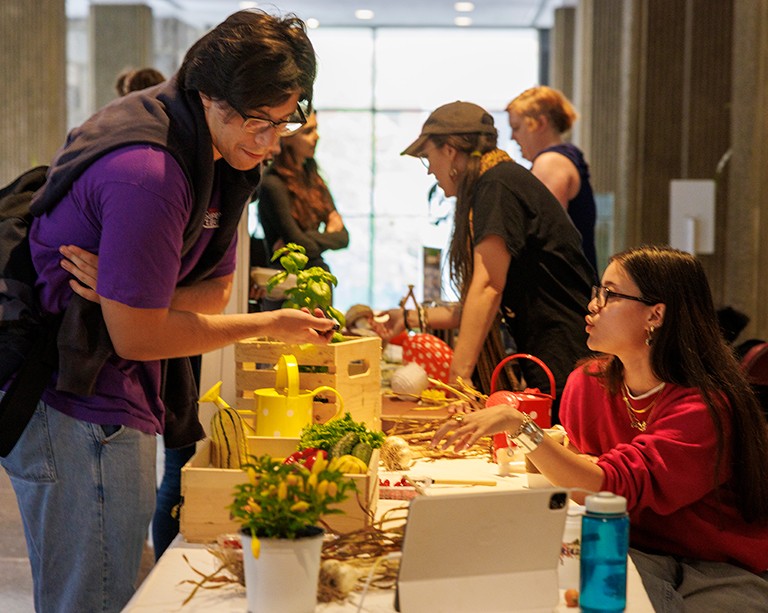Deanna Bowen’s two-storey mural to adorn the façade of the National Gallery of Canada

Artist Deanna Bowen describes her monumental piece “The Black Canadians (after Cooke)” as the “Blackity-ist, Black, Black thing” people have ever seen. More than 30 images are mounted “on a sea of black (so to speak) and it takes up a good two-thirds of all of that visible light space,” she told the CBC in a recent interview.
Bowen is assistant professor of intersectional, feminist and decolonial 2D-4D image making and co-director of the Post Image Cluster at Concordia’s Milieux Institute for Arts, Culture and Technology.
Installation of Bowen’s contribution — the second in an ongoing series at the National Gallery of Canada (NGC) in Ottawa entitled Leading with Women — is underway and slated for completion by July 15. This largest-ever mural to adorn the NGC will be viewable from blocks away, two storeys high, stretching the entire length of the windowed façade facing Major’s Hill Park.
The title and one of the photographs are derived from an article written by Britton Cooke for Maclean’s magazine in 1911 — one that presents his argument against Black immigration to Canada from the United States. As Bowen noted in her conversation with CBC Radio’s Ottawa Morning show host Hallie Cotnam: “It was a really inflammatory, deeply, deeply racist article basically saying that these Black and Black Indigenous people coming in from the United States are horrible. We don’t want them.”
And this contextualizes the hatred experienced by Bowen’s own family, she related. She is a descendant of two Alabama- and Kentucky-born Black Prairie pioneer families from Amber Valley and Campsie, Alberta.
Bowen has been creating work based on her family’s experience for more than 25 years as a form of “self-recovery,” a means of “working through generational trauma” and survival, she shared in the CBC interview. Building a chronology from her great-great-great grandfather to the birth of her mother in 1943, “After Cooke” traces Bowen’s family history alongside larger histories of discrimination in North America.
 Deanna Bowen: “I wanted to produce something you couldn’t pass by easily.”
Deanna Bowen: “I wanted to produce something you couldn’t pass by easily.”
Bracing for the scale
On Bowen’s mind are both the scale of the piece and that of the conversations that will ensue.
“I wanted to produce something you couldn’t pass by easily,” she told Cotnam, but having never produced something of this size, she has some concerns about the mural’s legibility. Bowen noted, however, that the massive scale will help generate a conversation. And having been in the business of “piecing together these kind of chronologies for a while now,” she said she has a “sense of what buttons it’s going to push.”
One major source of pushback she anticipates is the inclusion of clear images of white supremacists and of the Group of Seven within her 17 panels. Ironically, it is not the group she takes aim at per se, but a man often noted in their company.
‘Barker Fairly is who I’m after’
As Bowen relayed to the CBC, Barker Fairly was an artist, art historian and strong advocate for the Group of Seven. “He also signed that petition back in 1911 calling for the banning of Blacks coming into the country and the supporting documentation around that also went so far as to say that if the government didn’t stop, that they would resort to lynch-mob killings,” she said in the interview.
“So, Barker Fairly is who I am after.”
 Six of the Group of Seven, 1920. Barker Fairley, shown in vignette, was not a member. | Archives of Ontario
Six of the Group of Seven, 1920. Barker Fairley, shown in vignette, was not a member. | Archives of Ontario
While Bowen said she appreciates how challenging all of this can be for viewers to encounter, she insists the conversation needs to happen. “Because what it unearthed is a lot of hostility toward particular people, racialized people, Indigenous people. And that’s just something we haven’t been interested in engaging with in a meaningful way.”
The official opening of Deanna Bowen’s “The Black Canadians (after Cooke)” will be held at the National Gallery of Canada on Emancipation Day — Tuesday, August 1, at 5 p.m. Following a discussion with Jonathan Shaughnessy, director of curatorial initiatives, Bowen will be signing copies of her most recent book.
“The Black Canadians (after Cooke)” by Deanna Bowen opens August 1 at the National Gallery of Canada in Ottawa.
Find out more about Concordia’s Milieux Institute for Arts, Culture, Technology.


